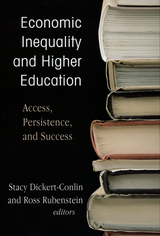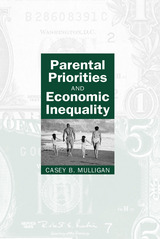2 books about Economic Inequality

Economic Inequality and Higher Education
Access, Persistence, and Success
Stacy Dickert-Conlin
Russell Sage Foundation, 2007
The vast disparities in college attendance and graduation rates between students from different class backgrounds is a growing social concern. Economic Inequality and Higher Education investigates the connection between income inequality and unequal access to higher education, and proposes solutions that the state and federal governments and schools themselves can undertake to make college accessible to students from all backgrounds. Economic Inequality and Higher Education convenes experts from the fields of education, economics, and public policy to assess the barriers that prevent low-income students from completing college. For many students from disadvantaged socioeconomic backgrounds, the challenge isn't getting into college, but getting out with a degree. Helping this group will require improving the quality of education in the community colleges and lower-tier public universities they are most likely to attend. Documenting the extensive disjuncture between the content of state-mandated high school testing and college placement exams, Michael Kirst calls for greater alignment between K-12 and college education. Amanda Pallais and Sarah Turner examine barriers to access at elite universities for low-income students—including tuition costs, lack of information, and poor high school records—as well as recent initiatives to increase socioeconomic diversity at private and public universities. Top private universities have increased the level and transparency of financial aid, while elite public universities have focused on outreach, mentoring, and counseling, and both sets of reforms show signs of success. Ron Ehrenberg notes that financial aid policies in both public and private universities have recently shifted towards merit-based aid, away from the need-based aid that is most helpful to low-income students. Ehrenberg calls on government policy makers to create incentives for colleges to increase their representation of low-income students. Higher education is often vaunted as the primary engine of upward mobility. Instead, as inequality in America rises, colleges may be reproducing income disparities from one generation to the next. Economic Inequality and Higher Education illuminates this worrisome trend and suggests reforms that educational institutions and the government must implement to make the dream of a college degree a reality for all motivated students.
[more]

Parental Priorities and Economic Inequality
Casey B. Mulligan
University of Chicago Press, 1997
What determines whether children grow up to be rich or poor? Arguing that parental actions are some of the most important sources of wealth inequality, Casey B. Mulligan investigates the transmission of economic status from one generation to the next by constructing an economic model of parental preferences.
In Mulligan's model, parents determine the degree of their altruistic concern for their children and spend time with and resources on them accordingly—just as they might make choices about how they spend money. Mulligan tests his model against both old and new evidence on the intergenerational transmission of consumption, earnings, and wealth, including models that emphasize "financial constraints." One major prediction of Mulligan's model confirmed by the evidence is that children of wealthy parents typically spend more than they earn.
Mulligan's innovative approach can also help explain other important behavior, such as charitable giving and "corporate loyalty," and will appeal to a wide range of quantitatively oriented social scientists and sociobiologists.
In Mulligan's model, parents determine the degree of their altruistic concern for their children and spend time with and resources on them accordingly—just as they might make choices about how they spend money. Mulligan tests his model against both old and new evidence on the intergenerational transmission of consumption, earnings, and wealth, including models that emphasize "financial constraints." One major prediction of Mulligan's model confirmed by the evidence is that children of wealthy parents typically spend more than they earn.
Mulligan's innovative approach can also help explain other important behavior, such as charitable giving and "corporate loyalty," and will appeal to a wide range of quantitatively oriented social scientists and sociobiologists.
[more]
READERS
Browse our collection.
PUBLISHERS
See BiblioVault's publisher services.
STUDENT SERVICES
Files for college accessibility offices.
UChicago Accessibility Resources
home | accessibility | search | about | contact us
BiblioVault ® 2001 - 2024
The University of Chicago Press









